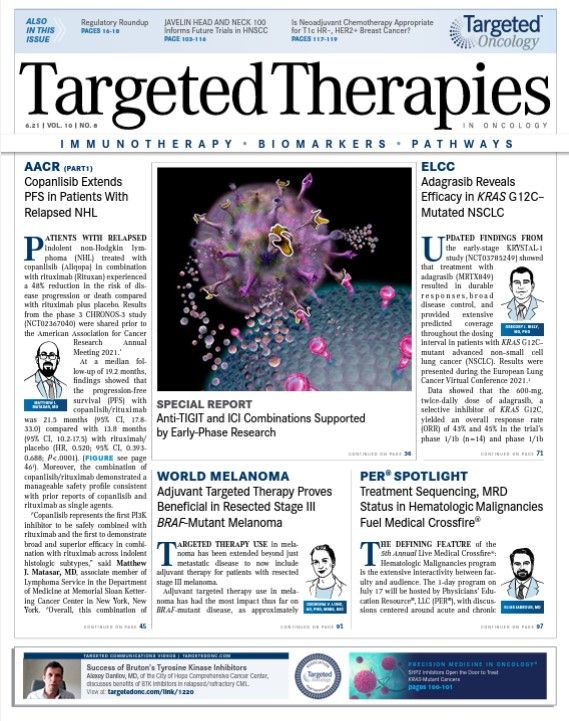PODCAST PREVIEW: Modern Strategies Are Improving Immunotherapy in Cancer
An excerpt from the Targeted Talks highlights the interest in PD-1/PD-L1 and CTLA-4 antibodies, their mechanisms of action, and the potential they bring to the immunotherapy field.
Jason Luke, MD

In this excerpt from the third episode, second season, of the Targeted Talks podcast, Jason Luke, MD, an associate professor of medicine in the Division of Hematology/Oncology and director of the Cancer Immunotherapeutics Center at University of Pittsburgh Medical Center Hillman Cancer in Pennsylvania, leads a discussion with Sandip P. Patel, MD, a medical oncologist and associate professor of medicine at University of California San Diego Health, about the future of immunotherapeutics in cancer care.
Sandip P. Patel, MD

Immune checkpoint inhibition with PD-1/PD-L1 and CTLA-4 antibodies has been well established in the treatment of many cancers, and investigators want to continue building upon the responses seen with immunotherapy agents. A newer approach to immunotherapy across tumor types involves targeting other immune checkpoints, such as TIGIT and LAG-3, in combination with the established PD-1/PD-L1 inhibitors.
During this segment from the podcast, Luke and Patel explain the interest in these checkpoints, their mechanisms of action, and the potential they bring to the immunotherapy field.
PATEL: We’re always looking for the next best thing, because when patients, unfortunately, have progression on IO or chemotherapy/IO strategies there are not as many tools in the tool shed as we’d like....Getting to those next therapies, I think, is crucial.
I think TIGIT is one of the more interesting ones in thoracic oncology. It’s being developed in non–small cell lung cancer and small cell lung cancer….I think it’s important for us to remember that cancer effectively is stealing from the body’s native playbook to shield itself from an immune response. If I’m in the laboratory and I want to get PD-L1 positive control, I’m using the placenta. Why? Because half of the fetus is immunologically foreign to the mother. So the placenta has to have a robust immunologic barrier. And so TIGIT and all these other pathways represent natural ways for the body to [tamp] down overactive immune surveillance. A lot of these are brakes on the immune response. TIGIT actually acts on a slightly different pathway.
But, broadly, it looks as though in combination with PD-1 inhibitors there may be some synergy. Now one of the issues with TIGIT…is it’s unlikely that many of these drugs are going to be grand slam home- runs across 20 different cancer types. I think PD-1/PD-L1 has had efficacy across so many different cohorts. But we’ve seen some recent data with atezolizumab [Tecentriq] combinations, pembrolizumab [Keytruda] combinations….One of the issues we have in the field is we’re just combining everything with a PD-1 inhibitor because we’re assuming all our patients’ immunologic problems are [solved with] PD-1 plus novel therapy X, rather than getting to the biomarker space. It’s as if we did NGS [next-generation sequencing] testing and we gave dabrafenib [Tafinlar]/trametinib [Mekinist] to everyone regardless [of whether] they had a BRAF mutation. That’s effectively what we’re doing with IO development. I think that’s part of why we struggle. One of the areas I’m most interested in is...how we [select biomarkers for] patients to optimize their outcomes and personalize their immunotherapy
LUKE: I think it’s worth pointing out that this is relevant to TIGIT as well as LAG-3. In our fundamental working models, some patients have mounted an immune response against the tumor, and we can measure this by the infiltration of CD8 cells or PD-L1 expression. But a lot of the secondary checkpoint molecules that we’ve been interested in targeting just conceptually are only going to be present when you have a very robust immune response. Going back to the TIGIT example in lung cancer, the original study that really put this on the map, [CITYSCAPE, NCT03563716], was a study in the front line of lung cancer with high PD-L1 [expression] where they showed that adding TIGIT could improve on PD-L1 monotherapy. The model there is that that’s where the target is—in that high interferon-associated tumor microenvironment. And similarly in melanoma, we’ve recently seen data on the anti–LAG-3 antibody relatlimab. Conceptually, this is somewhat similar, where in melanoma in the front line the majority of patients are going to have a high interferon-activated tumor microenvironment with high CD8-type PD-L1. But that’s where you’re going to see high levels of LAG-3 expression as well. A number of companies developed anti–LAG-3 antibodies some years back, and the early consensus was “it doesn’t work,” but that shows the importance of biomarker stratification and doing the right kind of clinical trial to find those patients. In lung cancer, that’s the front line with PD-L1 high; in melanoma, again in the front line. I think that’s an important thing to be aware of, that the secondary checkpoints are activity because that’s where the biology is. The biomarker and the biology are intertwined there. But we haven’t been following that so closely over the past few years, which is why I think it’s been slow with development.likely only going to be effective where PD-1 already has activity because that’s where the biology is. The biomarker and the biology are intertwined there. But we haven’t been following that so closely over the past few years, which is why I think it’s been slow with development.
PATEL: Jason, you bring up a great point. The genomic biomarkers, the genomics are that cancer’s destiny. If you find a BRAF mutation regardless [of whether] you biopsied in the adjuvant setting, in the relapse setting, if it’s that cancer, that genomics is unchanged; it’s like a stop sign, right? Meanwhile, for these IO biomarkers, they’re more like a traffic light, meaning they’re dynamic, they change over time, [and are relative to] when we get the biopsy, which lesion are we biopsying. And so, when I say our IO biomarker development has been hampered, I don’t mean that it’s [from] a lack of trying, it’s more that it’s more complex because these are dynamic changes on circulating immune cells, which is very different than our genomics. And…part of the reason we’re getting so many good genomic drugs is we’re finding these targets, we’re able to accurately identify these patients who have these targets, and we’re able to give drugs that are engineered. One of the issues [with] IO biomarkers is we see the efficacy of the agent and then we try to backfill what the biomarker story potentially is. One of the areas I’m most interested to see is LAG-3. In the phase 1/2 drug development for relatlimab, it seemed as though LAG-3 expression on the T cell conferred with clinical response. [In the melanoma study, I want to see] if that dynamic biomarker is inducible. When were the biopsies done? What were the levels? These things matter because when you give interferon-γ stimulation or radiation, it changes the biomarker. When you take that photograph matters.
LUKE: I want to emphasize on a practical reality for practitioners who maybe don’t follow these trials quite so closely, there’s been a long-standing discussion about combination immunotherapy as being more toxic [than monotherapy]. How have you understood that visa vie the TIGIT combination?
PATEL: I think combinations, just by addition, tend to be more toxic. But at least the data we’ve seen for TIGIT, at least in the small cohorts we’ve seen, drive up the rates of the toxicities most concerned about. I think with immune checkpoint blockade the more common toxicities we deal with in clinic are mainly cutaneous or thyroid related. Those tend to be minor and we tend not to have to interrupt or even give steroids for. The ones I think we worry about and keep us awake at night, are things like colitis, pneumonitis, myocarditis, you know, neuro-ophthalmic autoimmune complications, which are exceedingly rare but very concerning. The [rates] don’t seem to be particularly higher.
The immune response is a double-edged sword, meaning those therapies that are most likely to make an immunologically cold tumor hot….But making cold tumors hot, you’re much more likely to have friendly fire on the immune response....What you’re trying to do to the tumor microenvironment [is] you’re equally stimulating an immune response against normal epithelia. Meanwhile, if you’re making a warm tumor hotter—which is what TIGIT and some of these other molecules seem to be doing preclinically, though we don’t know for sure— you’re likely not as immune active and leading to as many of these irAEs [immune-related adverse events]. Sometimes the biology tells us about the toxicity in the sense that it’s a double-edged sword as far as these drugs go.
LUKE: I think that’s a really great point…that both the TIGIT combination and the LAG-3 combination, it does not appear that toxicity is increased. So I wanted to get this out on this podcast that, especially when we talk about combination immunotherapy being more toxic, it’s really that the CTLA-4 antibody is toxic. It’s not so much that blocking these checkpoints is necessarily more toxic. And for that reason, there is a lot of ongoing effort to do things [such as] bispecific antibodies to hit more than 1 checkpoint at a time. And…if you do this right, it doesn’t have to be more toxic than monotherapy approaches.

Survivorship Care Promotes Evidence-Based Approaches for Quality of Life and Beyond
March 21st 2025Frank J. Penedo, PhD, explains the challenges of survivorship care for patients with cancer and how he implements programs to support patients’ emotional, physical, and practical needs.
Read More